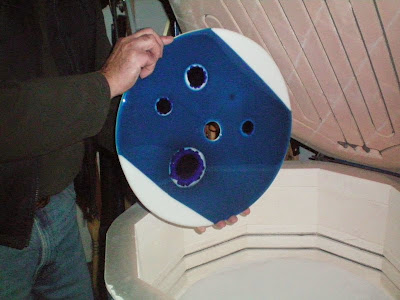This short
series on the so-called rules of kiln forming looks into their accuracy.
Wet
shelves cause bubbles
The common sense observation that water turns to steam as
the temperature rises above 100C and so could affect the glass, does not apply
in kiln forming (in most cases).
Firing at around 200°C per hour will give approximately
2.5 hours for any moisture to evaporate.
This is because the glass only begins to move after about 540°C. So,
unless you have a lot of water in your mould or shelf, the vapour will have
disappeared some time before the glass begins to move and conform to the shelf,
or round up at the edges. You may wish to leave the plugs out or crack the lid a little to allow the moisture to escape more easily.
3.bp.blogspot.com
The holes in this piece result from a combination of factors, not all of which might apply – layup, contaminants on shelf, firing too high or fast, low spots in shelf – but not moisture on shelf. Note that some of the holes have been filled with frit and refired.
bstiverson.files.wordpress.com
These holes are
more clearly the result of the layup, top temperature and speed of firing. The
three strips did not allow air to move out before the edges conformed to the
shelf. The bubbles at the joints of the
dark and yellow green seem to be the result of a poor fit, so having a thin
area where the air could push through the softened glass at top temperature.
Two circumstances where this moderate rate of advance does not apply are
- where extremely fast initial rates of advance, such as in small jewellery scale firings are going to be used. Here the distance for the air or steam to escape is very small so there is little concern about causing bubbles from any cause.
- The other case is in casting, where there is a lot of both free water and chemically bound water in the moulds. Special considerations are required for investment moulds. In summary, the requirement is to dry the mould in some manner before the firing of the glass on top of, or in it. Plaster moulds require two kinds of water removal. One is to remove the moisture by air drying in a warm area for a week or longer. The second is to remove the chemically bound water which is usually done at about 200°C for a couple of hours before proceeding up in temperature. The length of time required for these two dryings relate to the size of the mould.
- where extremely fast initial rates of advance, such as in small jewellery scale firings are going to be used. Here the distance for the air or steam to escape is very small so there is little concern about causing bubbles from any cause.
- The other case is in casting, where there is a lot of both free water and chemically bound water in the moulds. Special considerations are required for investment moulds. In summary, the requirement is to dry the mould in some manner before the firing of the glass on top of, or in it. Plaster moulds require two kinds of water removal. One is to remove the moisture by air drying in a warm area for a week or longer. The second is to remove the chemically bound water which is usually done at about 200°C for a couple of hours before proceeding up in temperature. The length of time required for these two dryings relate to the size of the mould.
For shelves, you can air dry on top of a firing kiln, or
fire in the kiln at a rate of about 200°C per hour to 200°C and soak for 10 minutes, if you decide the shelf must be dry before firing. The plugs should be out, or the
door cracked a little to allow the moisture to escape easily. After the soak,
just turn the kiln off. You can open the
lid or door if you need a quick cool down.
The shelf will then be ready for a rapid rate of advance firing as there is no
moisture to be trapped by the glass conforming to the shelf. This of course, is rarely necessary although you may be more comfortable in using a pre-fired shelf.
All myths have an element of truth
in them otherwise they would not persist.
They also persist because people
listen to the “rules” rather than thinking about the principles and applying
them. It is when you understand the
principles that you can successfully break the “rules”.


No comments:
Post a Comment